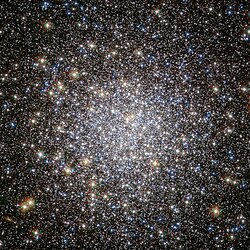Messier 5
| Messier 5 | |
|---|---|
 | |
| Messier 5 | |
| Observationsdata | |
| Stjärnbild | Ormen |
| Rektascension | 15t 18m 33,22s[1] |
| Deklination | +02° 04′ 51,7″[1] |
| Avstånd | 24 500 |
| Skenbar storlek | 4,2200' x 4,2200'[1] |
| Skenbar magnitud | +5,95[1] |
| Fysiska egenskaper | |
| Massa | 8,57 x 105M☉ |
| Radie | 80 ljusår |
| Antalet stjärnor | Cirka 100 000[2] |
| Ljusaste stjärnan | +12,2 |
| Uppskattad ålder | 10,62 miljarder år |
| Upptäckt | |
| Upptäcktsår | 1702 |
| Upptäckare | Gottfried Kirch |
| Andra beteckningar | |
| NGC 5904, GCI 34 | |
| Se också: Klotformiga stjärhopar, Lista över klotformiga stjärhopar | |
M5 (Messierobjekt 5) eller NGC 5904 är en klotformig stjärnhop i Ormens stjärnbild. Den upptäcktes av den tyske astronomen Gottfried Kirch 1702. M5 befinner sig på ett avstånd av cirka 24500 ljusår från jorden och har en skenbar magnitud på 5,6 vilket innebär att den går att observera med blotta ögat under gynnsamma förhållanden. Oftast behövs det åtminstone en kikare.[3] M5 innehåller uppskattningsvis mer än 100 000 stjärnor.[2] Med starkare teleskop går det att urskilja stjärnor, där de ljusstarkaste har skenbar magnitud 12,2.
Kirch upptäcktes stjärnhopen när han studerade en komet. Den franske astronomen Charles Messier, som gjorde Messier-katalogen noterade den 1764, men trodde att den var en nebulosa. Den tysk-brittiske astronomen William Herschel blev därför sedan den förste att upplösa individuella stjärnor i stjärnhopen med sitt teleskop 1791. Han kunde med sin instrumentering räkna till 200 stjärnor.
Bildgalleri
- M5 med ett vidvinkelfoto av den amerikanske matematikern Robert J. Vanderbei.
- M5 fotograferad med DSLR-kamera.
Referenser
- ^ [a b c d] ”Basic data: V* M 5 – Globular cluster” (på engelska). Centre de Données astronomiques de Strasbourg. http://simbad.u-strasbg.fr/simbad/sim-basic?Ident=M+5. Läst 16 maj 2020.
- ^ [a b] ”Messier 5” (på engelska). NASA. 2019. https://www.nasa.gov/feature/goddard/2017/messier-5. Läst 5 maj 2020.
- ^ Levy, David H. (2005) (på finska). Ihmeellinen Luonto: Tähtitaivas. Helsingfors: Gummerus. sid. 212. Läst 5 maj 2020
Externa länkar
- SEDS - Messier Object 5
 Wikimedia Commons har media som rör Messier 5.
Wikimedia Commons har media som rör Messier 5.
| ||||||||
Media som används på denna webbplats
Författare/Upphovsman: Rawastrodata, Licens: CC BY-SA 3.0
An armature photography of Messier 5 taken with a Nikon D300 DSLR.
Författare/Upphovsman: Robert J. Vanderbei, Licens: CC BY 2.5
Image of globular cluster M5 by Robert J. Vanderbei
The globular cluster Messier 5, shown here in this NASA/ESA Hubble Space Telescope image, is one of the oldest belonging to the Milky Way. The majority of its stars formed more than 12 billion years ago, but there are some unexpected newcomers on the scene, adding some vitality to this aging population.
Stars in globular clusters form in the same stellar nursery and grow old together. The most massive stars age quickly, exhausting their fuel supply in less than a million years, and end their lives in spectacular supernovae explosions. This process should have left the ancient cluster Messier 5 with only old, low-mass stars, which, as they have aged and cooled, have become red giants, while the oldest stars have evolved even further into blue horizontal branch stars.
Yet astronomers have spotted many young, blue stars in this cluster, hiding amongst the much more luminous ancient stars. Astronomers think that these laggard youngsters, called blue stragglers, were created either by stellar collisions or by the transfer of mass between binary stars. Such events are easy to imagine in densely populated globular clusters, in which up to a few million stars are tightly packed together.
Messier 5 lies at a distance of about 25 000 light-years in the constellation of Serpens (The Snake). This image was taken with Wide Field Channel of Hubble’s Advanced Camera for Surveys. The picture was created from images taken through a blue filter (F435W, coloured blue), a red filter (F625W, coloured green) and a near-infrared filter (F814W, coloured red). The total exposure times per filter were 750 s, 400 s and 567 s, respectively. The field of view is about 2.6 arcminutes across.




